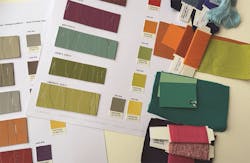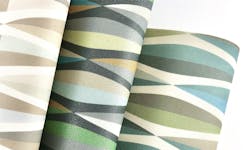Top 4 Considerations When Specifying Coated Fabrics for Upholstered Seating
Pictured above: Hybrids is a coated fabric collection from Anzea that includes four patterns—Dazzler, Stripes, Spree, Tartan—constructed of polyurethane with a silicone topcoat, ideal for healthcare applications. Photo courtesy of Anzea
Whether you specialize in healthcare design or are embarking on your first project, you will benefit by turning to the Association for Contract Textiles (ACT)—the definitive resource for contract textile information. ACT is a not-for-profit professional trade association representing fabric distributors, manufacturers of interior furnishings, fabric manufacturers and their suppliers, fabric finishers, testing labs, textile designers and others throughout the contract textile industry.
Here are tips from the “ACT Coated Fabric Selection Guide for Healthcare Upholstered Seating,” which the association recently published. The tool focuses on four key categories of considerations:
1. The fabric’s durability and performance
2. The facility’s cleaning, sanitizing and disinfecting protocols
3. The facility’s material ingredients/chemical transparency requirements
4. The upholstered furniture’s design and construction
In addition to helping you pin down your specification needs, the tool will help facilitate communication between you and your clients, coated fabric suppliers and upholstered furniture suppliers.
Durability and Performance Basics
When selecting coated fabrics for seating, it is important to understand the unique demands the fabric will encounter during its use and lifetime in specific healthcare settings. Real-world scenarios have shown that laboratory testing alone may not predict a textile’s actual performance in the field.
As you attempt to assess a fabric’s potential durability and appearance retention (lifespan), it is important to consider multiple performance characteristics beyond abrasion resistance.
ACT Recommends:
-
Identify the location where the furniture will be placed within the facility and determine the end-user’s and client stakeholder’s expectations for durability, appearance retention and lifespan (e.g., waiting area, patient room, nurses’ station, atrium, cafeteria).
-
Identify the renovation cycle review process, schedule and budget for replacement of upholsteries and/or furniture.
-
Verify that the coated fabric meets the ACT Voluntary Performance Guidelines minimum requirements for high-traffic public spaces. It is important to know that abrasion test results exceeding the ACT minimum guideline for abrasion are not an indicator of product lifespan. Comparative laboratory abrasion testing results on the same textiles frequently differ and testing methods do not necessarily correlate well with the variables encountered in actual use by the end-user.
Facility-Specific Cleaning, Sanitizing and Disinfecting
The most rigorous demand on the coated fabric will be frequent cleaning, sanitizing and disinfecting protocols used by the facility’s environmental services team to comply with Centers for Disease Control and Prevention (CDC) requirements. Cleaning, sanitizing and disinfecting are not the same.
Products that are used for soil and stain removal may not be effective disinfectants or sanitizers; conversely, products that disinfect or sanitize may not be effective for soil and stain removal. CDC guidelines recommend that surfaces be clean of soil and debris before sanitizing or disinfecting.
Coated fabrics such as vinyl, polyurethane and silicone that are smooth and non-permeable can be suitable upholstery options; however, it is important to note that they are soft-surface materials and may be adversely affected by some hard-surface cleaners, sanitizers and disinfectants.
Additionally, environmental services technicians typically do not adhere to manufacturers’ instructions to rinse off these chemicals because of their facility’s required protocols in specific patient care areas and/or limited time for completion of cleaning, sanitizing and disinfecting.
Material Ingredients/Chemicals Transparency
When selecting fabrics, you may need to factor in the individual facility’s priorities for addressing sustainability, environmental issues and the possible risk related to exposure to certain chemicals.
A decision to voluntarily comply with material ingredient criteria in certification programs such as LEED, WELL Building Standard, Healthier Hospital Initiative, Practice Greenhealth, Healthcare Without Harm, Green Globes and Living Building Challenge may limit fabric choices. Environmental considerations should be balanced with fabric performance requirements.
ACT Recommends:
-
Determine if the facility is seeking a certification.
-
Determine if material criteria, certification, material ingredient list or other protocol is required. If so, ask your coated fabric supplier to provide documentation that their product meets the requirements.
-
If the coated fabric meets material ingredient criteria in a certification program, confirm that it also complies with field durability requirements, including the fabric’s ability to withstand the cleaners, sanitizers and disinfectants being used in that facility as well as performance criteria identified in the Owner’s Project Requirements (OPR).
ACT Resources Online
ACT features a number of important guidelines and resources for specifying contract textiles to designers and specifiers, including:
- Voluntary Performance Guidelines
- Coated Fabric Selection Guide for Healthcare Upholstered Seating
- Coated Fabric Testing Guide for Healthcare Upholstered Seating
- TM 1-2020: Assessing Resistance to Liquid Cleaners, Sanitizers, and Disinfectants
- Abrasion Resistance: Considerations for Specifiers
- Video Tutorial on ACT Voluntary Performance Guidelines
- Request Form: IDCEC Approved CEU Courses (4 available)
To download these resources, visit contracttextiles.org
Furniture Design and Manufacturing
There can be significant differences in physical properties within and between the types of coated fabrics (e.g., vinyl, polyurethane and silicone). It is important to have a discussion with the furniture manufacturer regarding the type of coated fabric you would like to use.
ACT Recommends:
-
Review the furniture construction, style, design features, modularity/replaceability of parts and upholstering details (e.g., sharp corners, foam properties, welting, seam type, fastening methods) for potential upholstery wear and appearance retention issues.
-
Confirm that the specified coated fabric has been approved for the selected furniture by the furniture manufacturer. If you are using a Customer’s Own Material (COM), note that additional time may be required for approval testing and special handling.
-
Carefully review furniture and coated fabric warranties.
Above all, ACT emphasizes the importance of partnering with your coated fabric suppliers and furniture manufacturers to benefit from their insights and first-hand experiences, including:
Coated Fabric Supplier:
-
General information on suitable end-uses for the coated fabric
-
Relevant coated fabric test results
-
Recommended maintenance, lab-tested cleaners/sanitizers/disinfectants and their usage protocols
Furniture Manufacturer:
-
Coated fabric’s suitability for application on specific product
-
Customer’s Own Material (COM) approval
By following these recommendations, designers can have greater confidence that the upholstery fabrics they specify in healthcare applications will both look and perform beautifully.
Experience other How to Specify topics:




